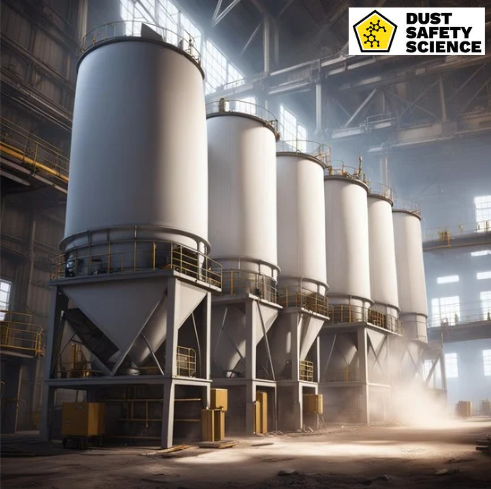Published May 22, 2024 Authored by Dr. Chris Cloney and Jon Barrett of Dust Safety Science

Understanding Dust Collector Explosions
Dust collector explosions are a serious hazard in many industries, including manufacturing, woodworking, food processing, and pharmaceuticals. Combustible dust in these environments creates a significant risk of explosion, which can result in severe damage, injuries, and even fatalities. To mitigate these dust collectors risk, it’s essential to implement comprehensive dust collection and dust explosion protection strategies. The US Chemical Safety Board, CSB, found that in all industries, dust collectors are the equipment most often involved in incidents; similarly, Zalosh et al. (2005) report that dust collectors account for more than 40 percent of all dust explosions.
Combustible dust refers to fine particles suspended in the air, capable of igniting under certain conditions, and moisture content, leading to fires or explosions. When these dust particles accumulate in sufficient quantities and encounter an ignition source, the resulting conflagration can be devastating. These airborne particles can ignite with a spark or flame, leading to combustion and potentially causing a fire or explosion. Other materials and products, such as grain, flour, paper, wood, metal, coal, plastic, cotton, and rubber that may combust in powdered form are extensive and include a wide range of materials. Some materials, such as Zinc or Potatoes are not combustible in larger pieces but can catch fire, when pulverized to fine dust and small in particle size. The US Occupational Safety and Health Administration (OSHA) maintains a comprehensive list of combustible materials.
What Causes Dust Collector Explosions?
Dust explosions occur when combustible dust accumulates and comes into contact with an ignition source. Ignition sources can happen in various ways, such as through static electricity, friction, overheating, or open flames. The resulting dust explosion can be devastating, causing structural damage, dust collectors and equipment destruction, and a serious threat to personnel safety in an industrial facility.
The NFPA 654 Standard for the Prevention of Fire and Dust Explosions from the Manufacturing, Processing, and Handling of Combustible Particulate Solids, provides guidance on combustible dust suppression and dust control. The NFPA 654 Standard is referenced by OSHA’s Combustible Dust National Emphasis Program (NEP) to identify dust hazards and define mitigation strategies that help prevent a dust explosion. The standard provides industry-recognized safety practices for facility and systems design, process equipment protection, fugitive dust control and housekeeping, ignition source identification and control, fire protection, training and procedures, inspection, and maintenance. To prevent a dust explosion, you need to prevent at least one of the five elements of the dust explosion pentagon. The key is to prevent and eliminate the creation of the combustible dusts. Without fuel, the dust explosion cannot occur, the events of a fire are also much less likely to happen
The Occupational Safety and Health Administration (OSHA) in the United States defines combustible dust as “a solid material composed of distinct particles or pieces, regardless of size, shape, or chemical composition, which presents a fire or deflagration hazard when suspended in air or some other oxidizing medium over a range of concentrations. Understanding these explosive dust characteristics is vital for identifying combustible dust hazards, managing the risks associated with combustible dust inside a dust collector, ensuring workplace occupational safety and compliance, and preventing a combustible dust explosion.
Effective Explosion Protection System
Implementing robust dust collection and ventilation systems helps minimize the accumulation of dust, inside a dust collector, reducing the likelihood of ignition. Regular dust collectors equipment maintenance and housekeeping practices further mitigate the risk of dust related incidents. Determining the combustibility of dust present in your facility requires professional evaluation through laboratory testing. This process involves igniting a sample of the dust in a controlled environment, such as a dust collector, and analyzing key parameters to assess the potential explosion risks. Dust explosions and incidents have occurred all around the world. Whichever system you install, make certain to use certified explosion protection devices, and ensure active explosion protection, and active systems.
Explosion Venting
Explosion venting is a passive explosion protection method that involves the installation of explosion vents and control panel on dust collectors. Regarding explosion venting, these vents are designed to relieve pressure wave during an explosion, directing the blast away from personnel and critical equipment. Properly sized and placed explosion vents can significantly reduce the damage caused by an explosion. Explosion venting is the most commonly used passive system.
Designing Effective Explosion Vents
To design effective explosion vents, it’s essential to consider factors such as the size and shape of the dust collector, the properties of the dust, and the anticipated explosion pressure wave, in a confined space. Consulting with experts and adhering to relevant standards and guidelines, such as those provided by the National Fire Protection Association (NFPA), can ensure optimal venting solutions.
Explosion Suppression Systems
Explosion suppression systems detect and suppress explosions in their early stages. These systems with explosion protection equipment, and explosion pressure detectors, typically use sensors to detect the pressure rise or flame from an incipient explosion and activate suppression agents, such as chemical suppressants or inert gases, or water droplets, to quench the explosion before it can escalate.
Selecting a Suppression System
Selecting the right explosion suppression system depends on the specific requirements of your dust collection process. Considerations include the type of dust, the operating environment, and the response time needed to suppress an explosion effectively. Regular maintenance and testing of suppression systems, such as wet dust collectors, are also critical to ensure their reliability.
Isolation Systems
Isolation systems are designed to prevent the propagation of explosions from one part of the process to another. This is achieved when using mechanical or chemical barriers to isolate the dust collector from other equipment and process areas. Isolation systems can include rotary valves, chemical isolation barriers, and fast-acting isolation valves. These isolation systems are considered active systems and are fast acting.

Maintenance of Dust Collection Systems
Regular maintenance of dust collection systems is vital to ensure their safe and efficient operation, from explosive dust. This includes inspecting and cleaning filters, and filter cartridges, checking for wear and damage, and ensuring all components are functioning correctly. Preventive maintenance can help identify potential issues before they become serious hazards.
Housekeeping Practices to Minimize Dust Accumulation
Effective housekeeping practices per the NFPA standards, play a significant role in minimizing the risk of dust explosions. Regular cleaning of work areas, equipment, filter bags, and ductwork can prevent the accumulation of combustible dust, and suspended combustible dust, preventing secondary explosions. Using appropriate cleaning methods, such as vacuuming with explosion-proof vacuums, is essential to avoid creating dust clouds during cleaning.
Installing Monitoring Systems
Installing monitoring systems that continuously track the conditions within a collection system can provide early warning of potential hazards. These systems can include temperature and pressure sensors, and dust concentration monitors. Real-time monitoring allows immediate action to be taken if dangerous conditions are detected.
Automated Detection Systems
Automated detection systems can enhance safety by providing instant alerts and triggering protective measures in the event of an explosion. Integrating these systems with other safety equipment, such as suppression and isolation systems, can create a comprehensive and responsive explosion protection solution.
Relevant Standards and Regulations
Compliance with relevant standards and regulations is crucial to ensuring the safety of a dust collection systems. Key standards include those from the National Fire Protection Association (NFPA), the Occupational Safety and Health Administration (OSHA), and other industry-specific guidelines. Staying informed about updates and changes to these standards is essential for maintaining compliance.
Advances in Explosion Protection Technology
The field of explosion protection is continually evolving, with new technologies and solutions being developed to enhance safety. Advances in detection systems, suppression agents, real time data, and isolation devices are making it easier to protect against explosive dusts and dust explosions. Staying informed about these developments can help organizations adopt the latest and most effective safety measures.
Conclusion
Protecting against combustible dust particles, combustible dust explosions, and dust collector explosions requires a comprehensive approach that includes risk assessment from ignitions sources. An unprotected dust collector, may create potentially explosive atmospheres, with ignition sources, and airborne dust. An unprotected dust collection system and an unprotected dust collector produces a high pressure wave which can cause both a primary and secondary explosion. The implementation of explosion protection systems, regular maintenance and housekeeping, employee training, and compliance with NFPA standards and regulations. By taking proactive steps to address the risks associated with combustible dust, with active systems, organizations can create a safer working environment and minimize the potential for catastrophic explosions, in an industrial facility.
About Dust Safety Science
For more from Dr. Chris Cloney on Dust Collector Systems, visit this Podcast: Top Five Mistakes Companies Make in Their Dust Collection System Design

Resources:
Visit Dust Safety Science (Global Incident Tracking)
Visit Dust Safety Academy (Resources, Training, and Events)
Visit Dust Safety Professionals (Need Help? Get Support Today!)
Visit Dust Safety Journal for the Complimentary, Dust Safety Science Monthly Journal
Subscribe to our Complimentary, Dust Safety Science Newsletter at Dust Safety Science Newsletter
Visit the Dust Safety Science blog for written articles on combustible dust safety including the latest research, expert opinions, and state-of-the-art in fire and explosion protection.
